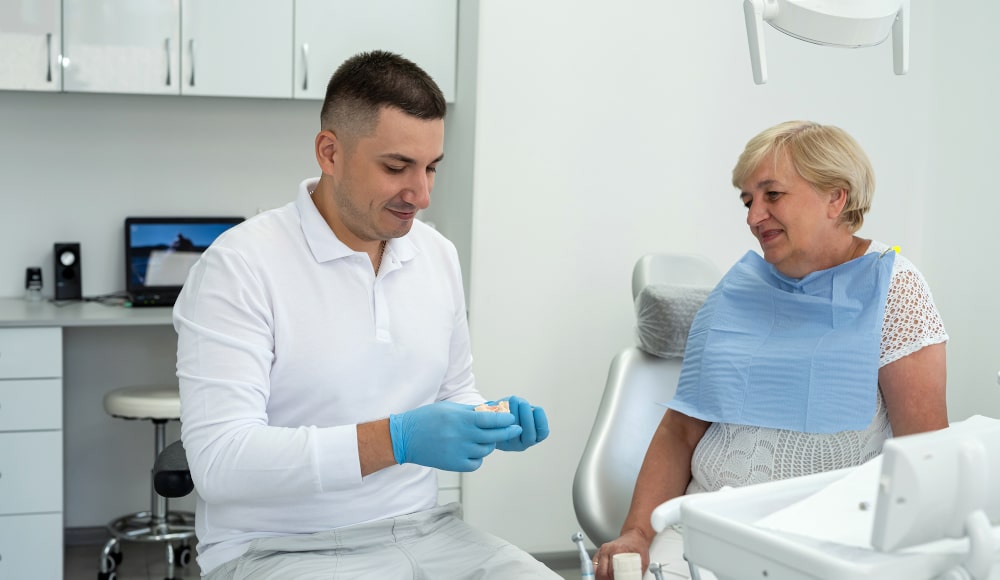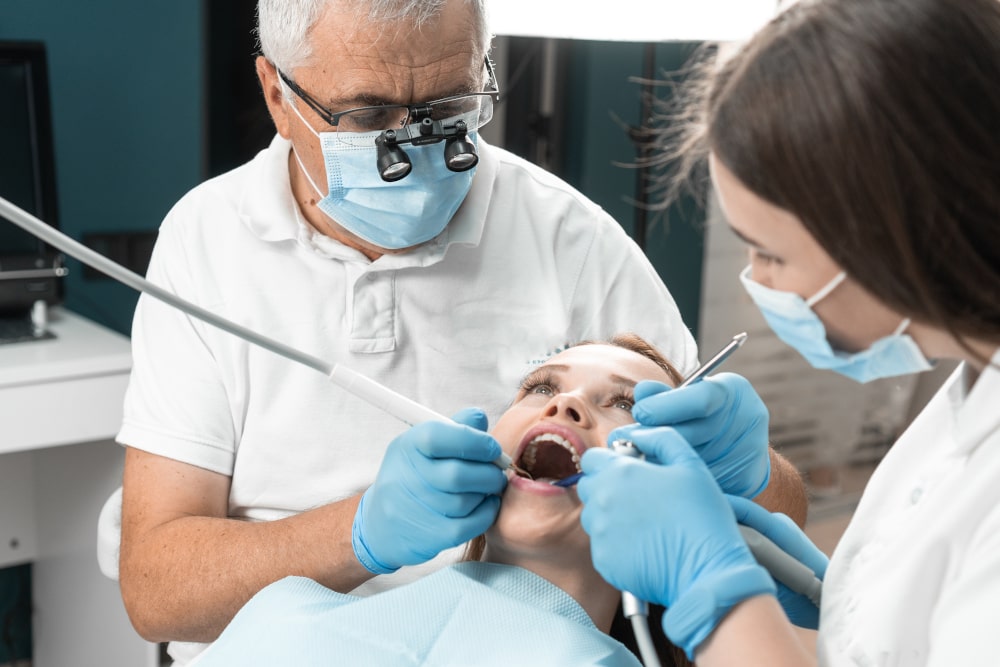
Dental Implant Recovery: What to Expect After Surgery
Key Takeaways
- Initial recovery lasts 1–2 weeks, with swelling, mild pain, and slight bleeding peaking within the first 48 hours.
- Complete healing takes 3–6 months, as osseointegration (bone fusion with the implant) is the most critical stage.
- Follow strict aftercare instructions: soft diet, gentle oral hygiene, and avoiding smoking or strenuous activity.
- Watch for warning signs like persistent pain, fever, pus, or implant mobility, and contact your dentist immediately.
- Recovery timelines vary depending on age, health, number of implants, and whether bone grafting or multiple extractions were involved.
- Mini implants may heal faster, but traditional implants provide stronger long-term stability.
- Consistent follow-up appointments are essential to ensure proper healing and implant longevity.
What happens immediately after dental implant surgery?
Imagine leaving the dentist’s chair after your implant procedure — numb, a little dazed, but curious about what comes next. The hours and days following dental implant surgery are a critical period that can shape the success of the entire treatment. This phase is all about managing discomfort, monitoring symptoms, and protecting the surgical site.
The first sensations: what’s normal
Within the first few hours post-surgery, the effects of local anesthesia will begin to wear off. That’s when most patients start noticing:
- Mild to moderate pain near the implant site
- Swelling of the cheeks or jaw, which may peak around 48 hours
- Slight bleeding or oozing from the incision area
These symptoms, while unsettling, are expected. Ice packs wrapped in cloth can help with swelling, and pain is usually managed effectively with over-the-counter medications unless your oral surgeon prescribes otherwise.
Bleeding and gauze care
Bleeding is typically controlled with sterile gauze pads, which should be kept in place for about 30 to 60 minutes after surgery. If bleeding continues lightly, fresh gauze can be applied with gentle pressure.
Avoid disturbing the clot formation. That means:
- No spitting or rinsing for the first 24 hours
- No use of straws
- Avoid smoking or vigorous brushing.
Dr. Jacklyn Pivovarov, a recognized expert in cosmetic and restorative dentistry at Art of Dentistry, explains:
“The initial hours post-implant surgery are vital for blood clot stability. Patients should rest, hydrate, and strictly follow gauze and medication instructions to prevent complications.”
The first 24–48 hours
This is the most intense part of the post-op recovery. Key considerations include:
- Soft diet: Stick to cool or lukewarm soft foods such as yogurt, smoothies, and mashed potatoes.
- Medication: Anti-inflammatory and antibiotic prescriptions, if provided, should be taken exactly as directed.
- Rest: Elevating your head while sleeping can minimize swelling.
Monitoring is essential. Any of the following should prompt a call to your dental provider:
- Profuse bleeding that won’t stop
- Severe pain not managed by medication
. - Signs of infection (e.g., fever, pus, excessive swelling)
How long does it take to recover from dental implant surgery fully?
There’s no one-size-fits-all answer, but recovery from dental implant surgery is not a single event — it’s a process with distinct phases. The entire healing period can span several months depending on individual circumstances.
Average recovery timeline by phase
| Phase | Duration | Description |
|---|---|---|
| Initial Healing | 1–2 weeks | Soft tissue closes around the implant. Pain and swelling subside. |
| Osseointegration | 3–6 months | Bone fuses with the implant. No visible signs, but essential for success. |
| Final Restoration | 1–2 weeks | The crown or final prosthetic is placed once stability is confirmed. |
Factors that affect the recovery timeline
Recovery isn’t just about waiting — several key factors influence it:
- Age: Older adults may take longer to heal due to slower cell regeneration.
- Health status: Conditions like diabetes or osteoporosis can affect bone healing.
- Number of implants: Multiple implants, especially with grafting, extend healing time.
- Smoking: Nicotine restricts blood flow, impairing tissue and bone regeneration.
- Oral hygiene: Patients with excellent hygiene often experience smoother recovery.
What helps or hinders recovery
Speed up healing:
- Follow every instruction from your dental team.
- Maintain a nutrient-rich diet with adequate protein and calcium.
- Use prescribed rinses to avoid infection.
Delay healing:
- Skipping medications
- Poor brushing technique
- High sugar intake
The more complex the case — like sinus lifts, bone grafts, or zygomatic implants — the longer you should expect to heal.

What are the dental implant healing stages and their timelines?
Recovery isn’t linear. Each stage of healing plays a distinct biological role that leads to a functional, aesthetic tooth replacement. Here’s how it typically unfolds:
Stage 1: Inflammatory Phase (0–7 days)
This is your body’s natural response to surgical trauma. Symptoms like swelling, bruising, and mild discomfort are all part of the inflammatory cascade. The clot forms, and white blood cells begin to clean the area.
- Pain and inflammation peak at around 48 hours
- Gum tissue begins to close.
- No bone healing has occurred yet.
Stage 2: Osseointegration Phase (1–6 months)
This stage is invisible but essential. Osseointegration refers to the fusion of the implant with the surrounding bone, which makes it stable enough to support a crown.
- Begins within weeks after implant placement
- It can take up to 6 months, depending on bone density and health.
- No movement or loading should occur during this stage.
Stage 3: Soft Tissue Maturation and Final Integration (2–8 weeks post-osseointegration)
Once the bone has stabilized, the focus shifts to the gum tissue, which must contour naturally around the new prosthetic. This ensures long-term aesthetics and function.
- A temporary crown may be placed to shape the gum.
- Final crown inserted after full tissue healing.
- Bite adjustments are made if necessary.
Dr. Amir Guorgui adds:
“We never rush the final restoration. Even after bone healing, the gum line and occlusion must be perfect. That’s the artistry behind implantology.”
What are normal vs. concerning symptoms during recovery?
The difference between healing normally and experiencing a complication can be subtle, but it matters. Swelling and discomfort may feel alarming, but often they’re part of the body’s healing cascade. So, when should you worry?
What’s normal?
These symptoms typically occur within the first few days and are not a cause for concern:
- Swelling of the gums, cheeks, or jaw (usually peaks at 48–72 hours)
- Mild pain is manageable with OTC medication.
- Bruising along the face or gum tissue
- Slight bleeding or oozing from the site in the first 24–48 hours
Expect these signs to decrease gradually. Ice packs and rest can ease symptoms.
When to be concerned
The following symptoms warrant contacting your dental provider immediately:
- Fever over 38°C (100.4°F) after 48 hours
- Persistent or worsening pain that does not respond to medication
- Redness, swelling, or heat at the site after the third day
- Pus or foul-smelling discharge
- Implant movement or shifting
When in doubt
If a symptom doesn’t feel right, call your dentist. It's better to check than to miss a developing problem.
How should I care for my dental implants after surgery?
Effective aftercare is what transforms a successful surgery into a long-lasting result. Post-op care is about supporting healing, preventing infection, and avoiding stress on the implant site.
Step-by-step care guide
- First 24 hours:
- Avoid rinsing or brushing the surgical site.
- Use gauze as directed to control bleeding.
- Stick to soft, cool foods.
- After 24 hours:
- Begin rinsing gently with warm salt water (unless advised otherwise).
- Brush nearby teeth gently, but avoid the implant site.
- From day 3 onward:
- Resume light brushing near the implant with a soft-bristled brush.
- Use an antimicrobial rinse if prescribed.
- Long-term care:
- Floss daily using special implant-safe tools.
- Attend all follow-up appointments.
Foods to eat and avoid
Recommended:
- Smoothies
- Mashed potatoes
- Scrambled eggs
- Cooked cereals
Avoid:
- Crunchy snacks (chips, nuts)
- Sticky candies
- Hot beverages in the first 48 hours
Implant don’ts
- Don’t smoke: Nicotine restricts blood flow and delays healing.
- Don’t touch the implant area with fingers or tongue.
- Don’t skip follow-up visits — even if you feel fine.

How does recovery differ after multiple tooth extractions and implants?
When more than one tooth is extracted and replaced with implants, recovery becomes more complex. More surgical sites mean more trauma, and your body will need additional time and resources to heal.
Recovery timeline comparison
| Procedure Type | Typical Healing Duration | Notes |
|---|---|---|
| Single Implant | 3–6 months | Localized healing, faster recovery |
| Multiple Implants | 6–9 months | Greater bone impact, more sutures |
| Extraction + Implant | 6–10 months | Healing from both extraction and implant |
| Full Arch (All-on-4) | Up to 12 months | Bone grafts, complex adjustments |
What to expect
- More swelling: Especially in areas with multiple extractions
- Slightly more extended discomfort period (3–7 days)
- Higher risk of dry socket if extractions were recent
- Longer bone healing time, especially if grafting is involved
When can I return to work or physical activity after getting implants?
Getting dental implants isn’t just a surgical event — it affects your daily life. A key question patients ask is: When can I get back to normal? The answer depends on how invasive the procedure was and what your job or lifestyle demands.
Desk jobs vs. physical labour
For patients with sedentary or desk jobs, returning to work is often possible within 1–2 days, as long as they feel alert and aren’t taking strong painkillers. However, some may choose to wait until swelling has subsided or speech feels more natural.
For physically demanding jobs (construction, fitness training, etc.), a more extended rest period — typically 4–7 days — is recommended. Strenuous activity can increase blood pressure and disrupt clotting, risking bleeding or implant destabilization.
Exercise and gym activity
Avoid the gym for at least 3–5 days post-surgery. After that, light cardio may resume, but you must:
- Skip heavy lifting or intense workouts for 1–2 weeks
- Avoid contact sports or impact-related activities until cleared by your dentist
Signs you’re overdoing it include throbbing pain at the implant site, swelling that increases, or dizziness.
Can complications delay dental implant recovery?
While dental implant surgery boasts high success rates — often over 95% — complications can delay recovery and threaten long-term outcomes. The key is early identification and prevention.
Common complications
- Infection:
- Occurs when bacteria enter the surgical site
- Symptoms include redness, pus, and persistent swelling
- Often treated with antibiotics if caught early
- Implant rejection or failure:
- The body doesn’t accept the implant or fails to integrate
- Can result from poor bone density or autoimmune disorders
- May require removal and bone grafting before retrying
- Peri-implantitis:
- Similar to gum disease, but around an implant
- Caused by poor oral hygiene or existing periodontal issues
- Mechanical failure:
- Damage to the implant due to biting hard items or trauma
How to prevent setbacks
- Follow all hygiene instructions
- Avoid smoking and alcohol during recovery
- Attend every follow-up appointment
- Report abnormal symptoms early
How often should I follow up with my dentist during recovery?
Follow-up care isn’t just procedural — it’s what transforms short-term healing into long-term implant success. Frequency and focus of visits depend on where you are in the recovery cycle.
Early follow-ups
- First check-up: Usually scheduled within 7–10 days after surgery
- The dentist will examine healing, check sutures, and adjust medications if needed
When to call
You don’t need to wait for your next visit if you notice:
- Fever or pus
- Pain worsening after day 3
- The implant feels loose or mobile
These may require emergency evaluation to prevent implant loss.
Long-term care schedule
After the initial healing phase:
- 1-month visit: To monitor osseointegration
- 3- to 6-month check-up: For x-rays and gum health
- Annual cleanings: Just like natural teeth, implants need professional maintenance
The Canadian Dental Association recommends that patients with implants maintain the same frequency of dental visits as those with natural teeth, at least every 6 months.
What role does osseointegration play in the healing process?
If there's one biological term every implant patient should know, it's osseointegration. Without it, the implant is just a foreign object sitting in the jawbone. With it, you get a stable, permanent anchor for your new tooth.
What is osseointegration?
Osseointegration is the direct structural and functional connection between living bone and the surface of a dental implant. It was first observed by Dr. Per-Ingvar Brånemark, the Swedish orthopedic surgeon who pioneered modern implantology.
In simpler terms, your body treats the titanium implant as part of your anatomy, allowing the bone to grow tightly around it.
Timeline for osseointegration
- Begins within 1–2 weeks post-surgery
- Bone growth continues over 3 to 6 months
- Healing may extend to 9 months in older adults or patients with systemic conditions
Factors that influence success:
- Bone quality and density
- Absence of infection
- Zero micromovements during healing
- Non-smoking status
Why it matters
A successful osseointegration phase ensures:
- Stability: The implant won’t move under pressure
- Longevity: With proper care, implants can last decades
- Load-bearing function: It can support chewing forces without damaging the surrounding bone
If osseointegration fails, the implant must usually be removed, the area grafted, and the entire process restarted.

How does the healing process differ between traditional implants and mini-implants?
While both traditional and mini implants aim to restore missing teeth, their design and healing demands are notably different. Understanding these differences helps patients set realistic expectations and choose the best option for their needs.
Key differences between traditional and mini implants
| Feature | Traditional Implants | Mini Implants |
|---|---|---|
| Diameter | 3.5–6 mm | 1.8–3.3 mm |
| Bone Requirement | Higher | Lower |
| Healing Time | 3–6 months | 2–4 months |
| Osseointegration | Longer, more robust | Faster, may be less stable in long term |
| Final Crown Timing | Delayed | Sometimes immediate |
| Usage | Single crowns, bridges, full arch | Temporary or denture stabilization |
Recovery and stability
Traditional implants require more time to heal because they go deeper into the bone and need substantial osseointegration. Mini implants, being narrower and shorter, are often placed without flap surgery and may be loaded the same day, but that doesn’t make them suitable for every case.
What’s the bottom line on dental implant recovery?
Dental implant recovery is a layered process, but also a manageable one. With the right care, expert guidance, and patience, most patients can expect excellent long-term outcomes.
Summary of the recovery timeline
| Recovery Phase | Timeframe | Key Milestones |
|---|---|---|
| Post-Surgery | 1–3 days | Swelling, gauze use, and pain control |
| Initial Healing | 1–2 weeks | Gum closure, sutures dissolve |
| Osseointegration | 3–6 months | Bone fusion, stability check |
| Final Restoration | After 4–9 months | Crown placement, full bite function |
Ready for the next step?
If you're planning an implant or recovering from one, expert care is your best ally. The team at Pickering Smile Centre offers personalized guidance every step of the way.
